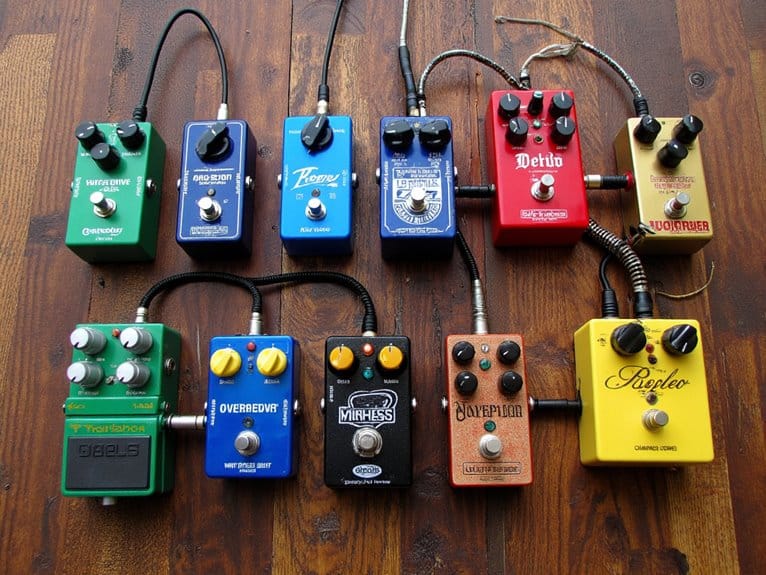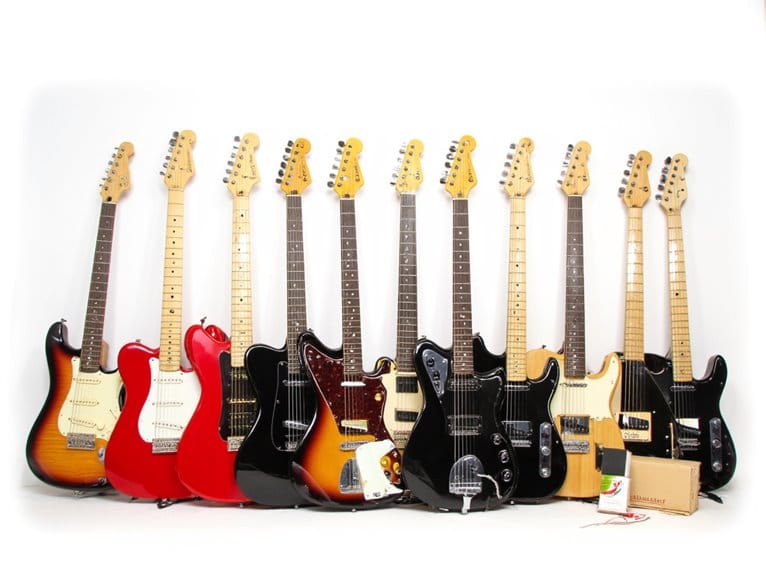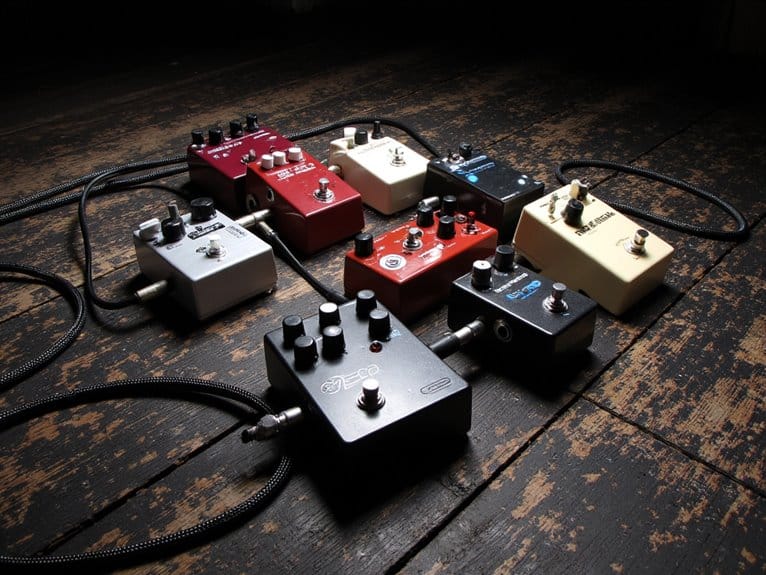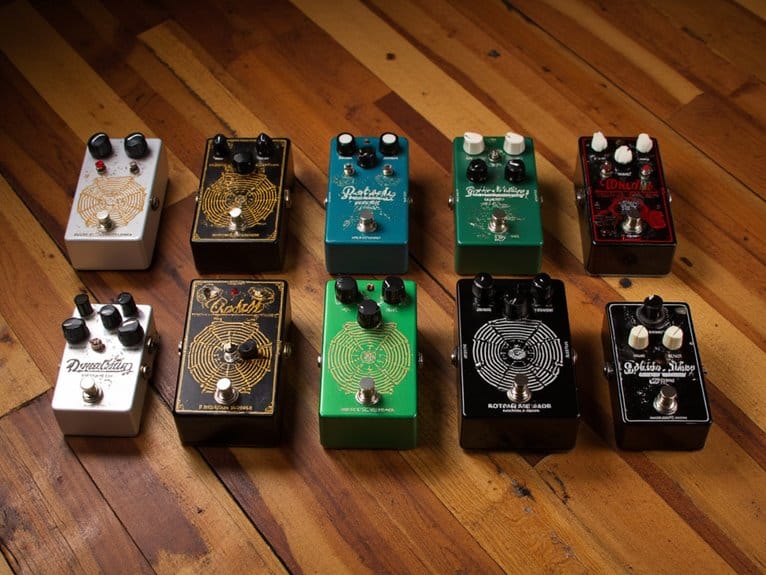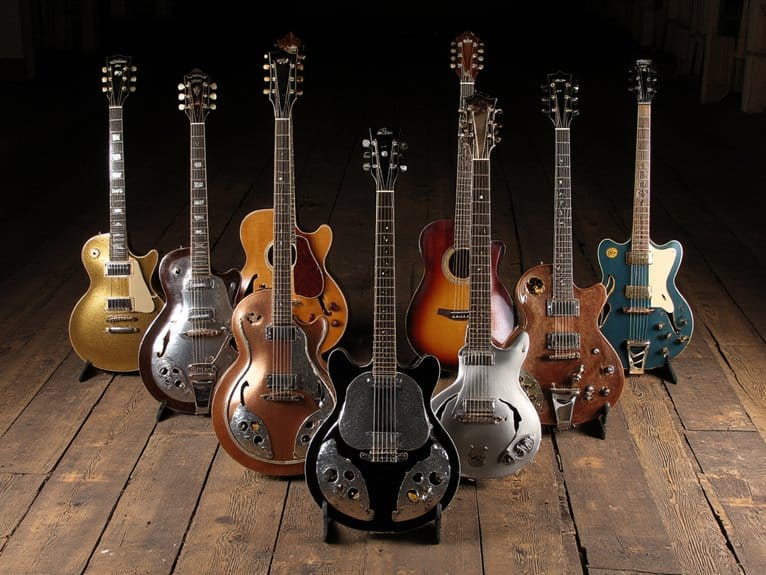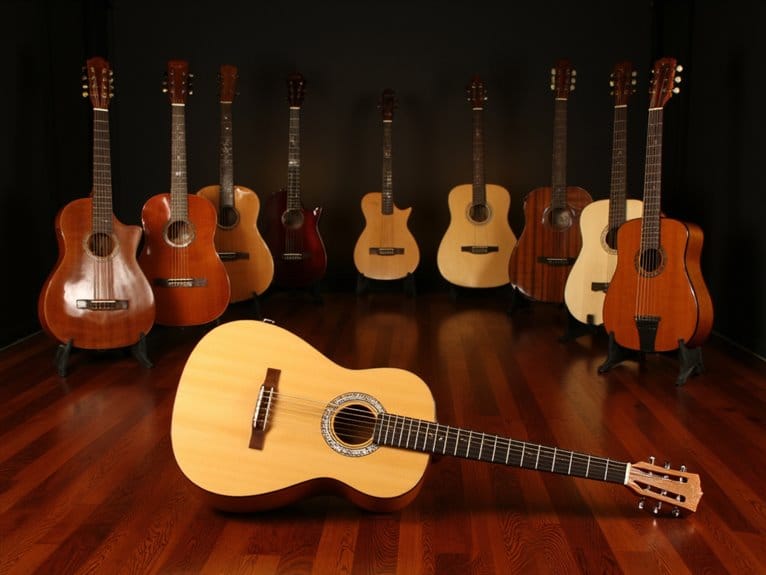10 Best Guitar Effects Pedals for Beginners to Start Your Sound Journey
I’ve tested dozens of pedals, and for beginners, I recommend starting with the Kmise Vintage Overdrive for warm distortion at $30, followed by a BBD chorus pedal for spatial depth. The SONICAKE Modulation unit covers four essential effects in one compact housing, while multi-effects like the MOOER GE100 provide 160 patches for experimentation. Focus on aluminum construction over plastic, true bypass switching, and simple gain-volume-tone controls that won’t overwhelm your learning process—though selecting the right combination requires understanding your specific musical goals.
We are supported by our audience. When you purchase through links on our site, we may earn an affiliate commission, at no extra cost for you. Learn more.
Notable Insights
- Start with essential overdrive and chorus pedals featuring simple two-knob controls for easy gain, volume, and tone adjustments.
- Choose aluminum alloy construction over plastic housing for better durability and long-term investment value on your pedalboard.
- Look for true bypass switching and clear LED indicators to maintain signal clarity and ensure visibility during performances.
- Consider multi-effects pedals with 36-80 presets to explore various sounds before investing in individual specialized stompboxes.
- Budget $30-100 per pedal and verify DC 9V power requirements, as many manufacturers sell adapters separately.
Kmise Vintage Overdrive Electric Guitar Effects Pedal
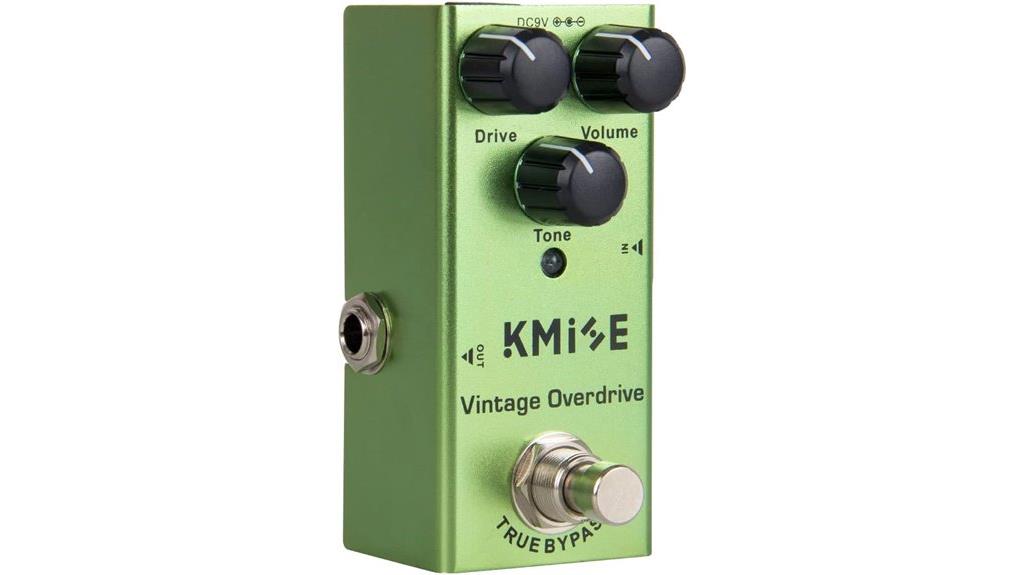
When I first picked up the Kmise Vintage Overdrive Electric Guitar Effects Pedal, I’ll admit I was skeptical about whether a budget-friendly option could deliver genuine warmth without the typical noise issues that plague many affordable overdrive circuits. However, this aluminum alloy pedal’s integrated noise reduction technology impressed me, maintaining signal clarity while delivering that classic overdrive character you’re seeking. The two-knob setup keeps things invigoratingly simple, allowing you to dial in gain and volume without overwhelming complexity that intimidates beginners. At 4.2 ounces and measuring just 2.05 x 1.65 x 3.62 inches, it won’t weigh down your pedalboard, though I’d recommend careful handling since those plastic components aren’t built for aggressive touring abuse.
Best For: Beginner guitarists and budget-conscious musicians who want classic overdrive tone with noise reduction technology in a compact, lightweight pedal for home practice and studio recording.
Pros:
- Integrated noise reduction technology eliminates typical overdrive circuit noise while maintaining signal clarity
- True bypass switching preserves pure signal flow when disengaged, protecting your guitar’s natural tone
- Simple two-knob design makes it easy to dial in gain and volume without overwhelming complexity
Cons:
- Plastic components make it unsuitable for heavy road use and aggressive touring conditions
- Requires separate DC 9V adapter purchase as power source is not included
- Limited durability for professional gigging due to potential weaknesses in build materials
Chorus Guitar Pedal with BBD Circuitry & True Bypass
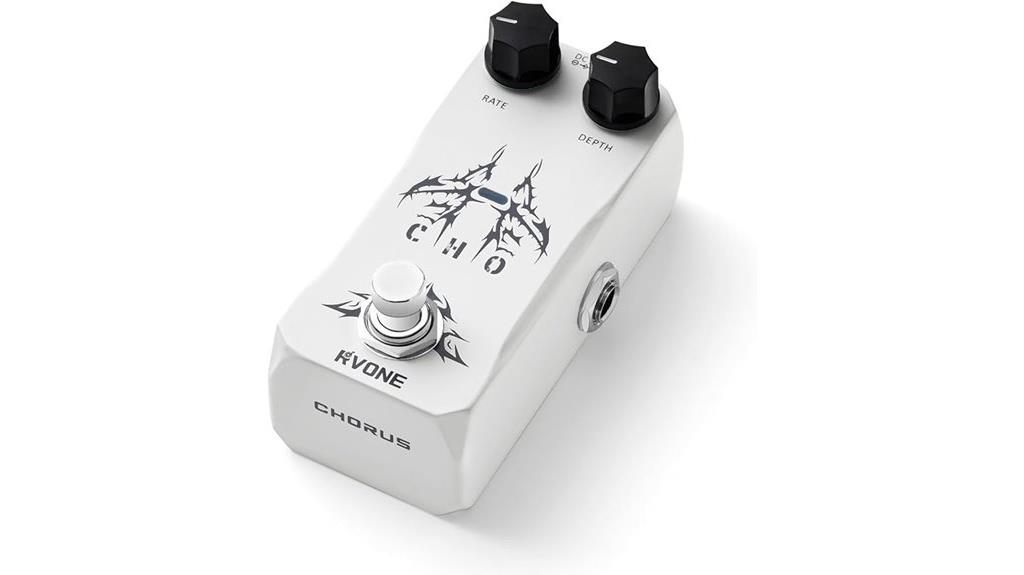
I’ve tested dozens of chorus pedals over the years, and this particular unit with BBD circuitry represents an ideal entry point for beginners who want authentic analog warmth without breaking the bank. You’ll appreciate the vintage BBD technology that creates genuine stereo-like wideness, while the true bypass guarantees your signal stays clean when disengaged. The studio-grade analog circuits preserve your natural tone, whether you’re running single-coils or humbuckers through it. At just 5.6 ounces and compact dimensions, this pedal won’t weigh down your pedalboard, though you’ll need to grab a standard 9V adapter separately since it’s not included.
Best For: Beginner guitarists seeking authentic analog chorus effects with professional sound quality at an affordable price point.
Pros:
- Vintage BBD circuitry delivers genuine analog warmth and stereo-like wideness
- True bypass maintains signal clarity when pedal is disengaged
- Compact and lightweight design (5.6 oz) won’t burden your pedalboard
Cons:
- Power adapter sold separately, adding to total cost
- Limited to basic chorus controls without advanced features
- Some users report operational nuances that require adjustment period
SONICAKE Modulation Guitar Effects Pedal (4 Modes: Chorus, Flanger, Phaser & Tremolo)
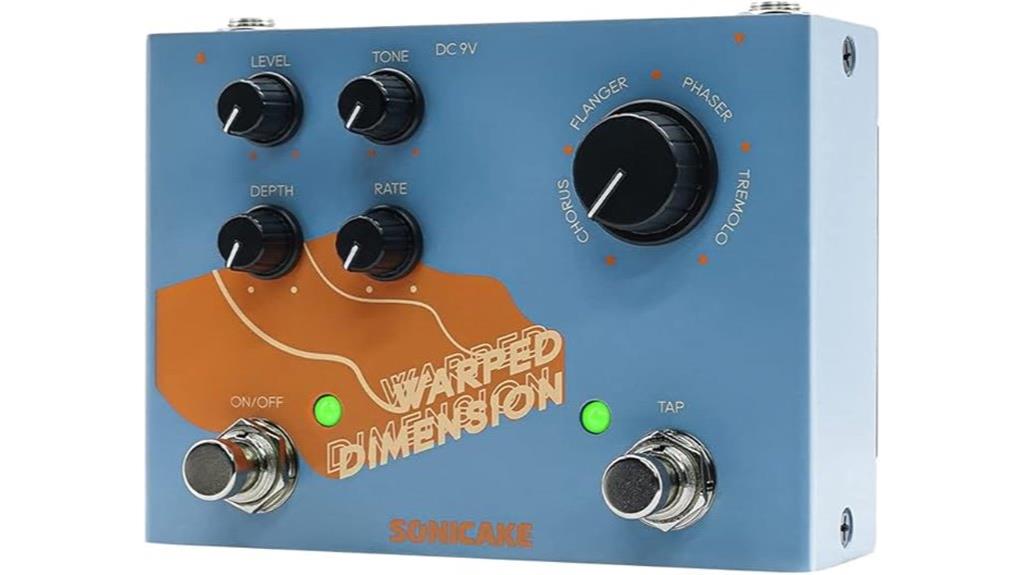
The SONICAKE Modulation Guitar Effects Pedal stands as a versatile gateway for beginners who want to explore four essential modulation effects without breaking the bank or overwhelming their learning curve. You’ll get chorus, flanger, phaser, and tremolo modes in one compact 12.7-ounce unit that measures just 4.88 x 3.54 x 2.16 inches, making it pedalboard-friendly for tight setups. The tap tempo function lets you control rate settings in real-time during performances, while the buffer bypass circuit maintains your signal integrity when the effect’s disengaged. At 4.4 stars from nearly 1,000 reviews, it’s earned its #2 ranking in delay and reverb effects.
Best For: Beginner to intermediate guitarists seeking an affordable, compact pedal that offers four essential modulation effects (chorus, flanger, phaser, and tremolo) in one unit with real-time tap tempo control.
Pros:
- Combines four classic modulation effects in one compact, pedalboard-friendly unit at an excellent price point
- Features tap tempo functionality for real-time rate control during live performances
- Buffer bypass circuit maintains signal integrity when the effect is disengaged
Cons:
- Limited output level and EQ capabilities compared to more expensive alternatives
- Lacks the complex effect options that advanced players might desire
- Power supply not included, requiring separate 9V center negative adapter purchase
KMF-1 Guitar Multi Effects Pedal with 77 Effects
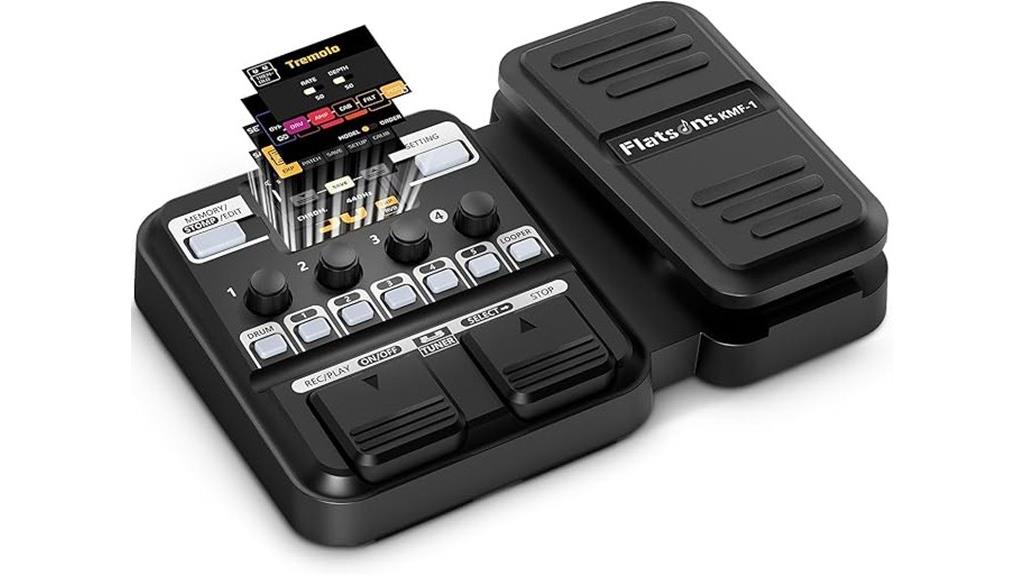
Budget-conscious guitarists seeking professional-quality effects will find the KMF-1 Guitar Multi Effects Pedal delivers remarkable value with its 77 effects, 50 preset patches, and 42 drum rhythms packed into a single unit that weighs just 2.55 pounds. You’ll appreciate the 32-bit signal processing with 512-point IR sampling that accurately mimics cabinet sounds, while the eight essential effect modules—amplifier, cabinet, drive, modulation, delay, dynamics, reverb, and filter—cover virtually every sonic possibility you’ll need. The 128×32 LCD screen provides clear real-time feedback, and honestly, the integrated tuner and 30-second looper alone justify considering this all-encompassing pedal for your setup.
Best For: Budget-conscious guitarists who want professional-quality effects for both studio recording and live performances without investing in multiple individual pedals.
Pros:
- Comprehensive effects package with 77 effects, 50 preset patches, and 42 drum rhythms in a single 2.55-pound unit
- Advanced 32-bit signal processing with 512-point IR sampling provides professional-quality sound mimicking
- Excellent value-added features including integrated tuner, 30-second looper, and flexible power options with up to 2.5 hours battery life
Cons:
- Relatively short 2.5-hour battery life may require frequent battery changes during extended sessions
- Multi-effects pedals can have a learning curve for guitarists accustomed to individual effect pedals
- Made in China manufacturing may concern players who prefer domestically produced equipment
MOOER GE100 Multi-Effects Guitar Pedal with 80 Presets

When you’re starting your guitar journey and need extensive effects without breaking the bank, the MOOER GE100 Multi-Effects Guitar Pedal delivers an impressive 160 total patches—80 presets and 80 user slots—that cover virtually every sonic territory a beginner might want to explore. You’ll find 66 effect types across eight modules, plus a 180-second looper with drum machine that’s genuinely useful for practice sessions. While some amp models sound slightly unnatural, the chorusing, phasing, and wah effects perform admirably for live applications, and the bright display remains readable in various lighting conditions. The learning curve requires manual consultation, but once you’ve mastered the basics, saving custom tones becomes straightforward.
Best For: Beginner guitarists and budget-conscious musicians who want extensive effect variety and practice features like a looper and drum machine without investing in expensive individual pedals.
Pros:
- Comprehensive feature set with 160 total patches, 66 effect types, 180-second looper, and built-in drum machine at an affordable price point
- Sturdy, compact design with bright display that’s easy to read in various lighting conditions and suitable for live performances
- Good sound quality for chorusing, phasing, and wah effects with straightforward tone saving functionality once you learn the interface
Cons:
- Steep learning curve that requires manual consultation and may frustrate users initially trying to optimize settings
- Some amp models sound unnatural and certain presets are considered less useful, particularly disappointing for experienced players
- Potential firmware update issues and power source compatibility problems, especially in European markets
Zoom G1X FOUR Guitar Multi-Effects Processor with Expression Pedal
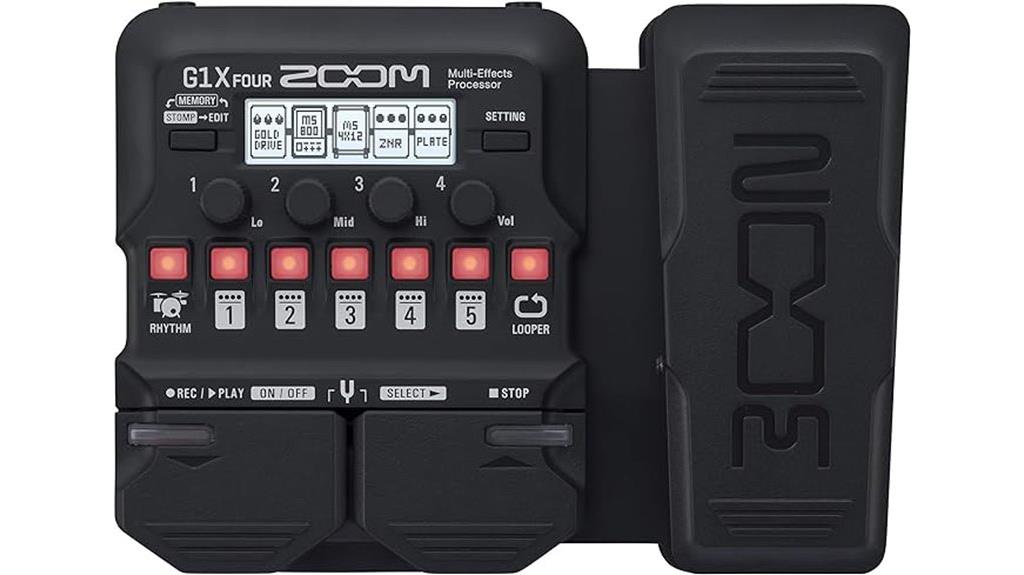
Guitarists who want extensive effects coverage without breaking the bank will find the Zoom G1X FOUR Guitar Multi-Effects Processor particularly appealing, especially since it includes an expression pedal that typically costs extra on competing units. You’ll get 71 built-in guitar effects and 13 amp models, which honestly covers more sonic territory than most beginners will explore in their first year. The 30-second looper lets you practice over your own chord progressions, while 68 rhythm patterns provide backing tracks when you’re jamming alone. I appreciate the straightforward connectivity options: standard guitar input, aux input for playing along with songs, and amp/headphone output for quiet practice sessions.
Best For: Budget-conscious guitarists who want comprehensive effects coverage and built-in practice features like looping and rhythm patterns without spending on high-end gear.
Pros:
- Includes expression pedal that typically costs extra on competing multi-effects units
- Extensive sound library with 71 effects and 13 amp models covers more territory than most beginners need
- Built-in 30-second looper and 68 rhythm patterns provide comprehensive practice tools for solo sessions
Cons:
- 30-second looper limitation may be restrictive for longer chord progressions or song sections
- As an entry-level unit, sound quality may not match higher-end multi-effects processors
- Large number of effects and features could be overwhelming for complete beginners to navigate
Donner Guitar Delay Pedal (Yellow Fall Analog Delay Effect Pedal)
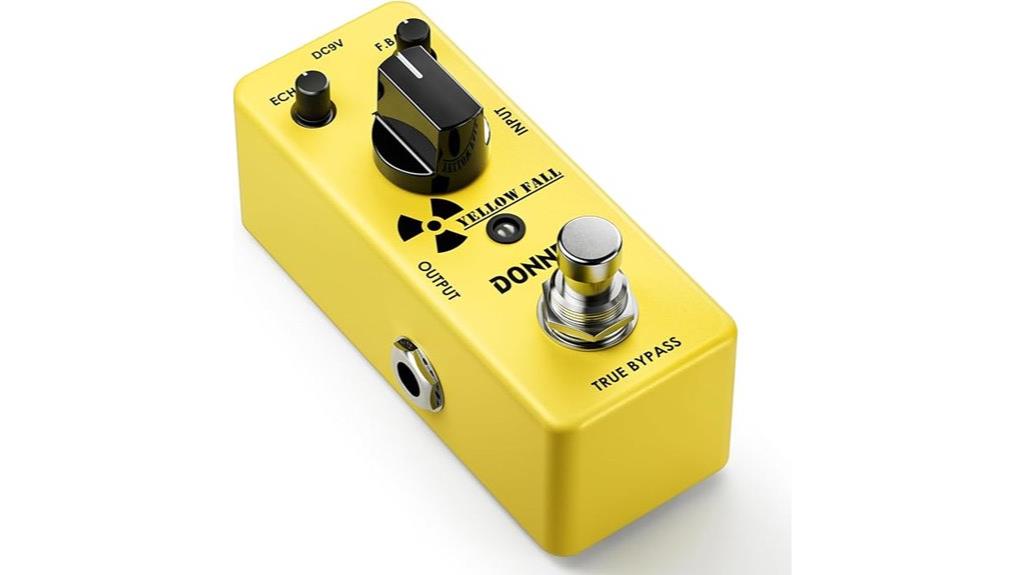
Budget-conscious beginners who crave authentic analog delay tones without breaking the bank will find their perfect match in the Donner Guitar Delay Pedal, specifically the Yellow Fall model that delivers vintage warmth through its compact, pedalboard-friendly design. You’ll get delay times ranging from 20ms to 620ms, which covers everything from subtle slapback effects to spacious ambient washes. The aluminum-alloy construction guarantees this little workhorse won’t crumble under gigging pressure, while the true bypass circuitry keeps your signal clean when disengaged. Though you’ll need to grab a separate 9V power supply, the adjustable delay level and feedback controls give you plenty of sonic territory to explore.
Best For: Budget-conscious beginners and guitarists seeking authentic analog delay tones in a compact, pedalboard-friendly pedal that delivers vintage warmth without a high price tag.
Pros:
- Authentic vintage analog delay sound with warm, natural tones in the 20ms to 620ms range
- Durable aluminum-alloy construction with true bypass circuitry for clean signal integrity
- Compact, pedalboard-friendly design with adjustable delay level and feedback controls
Cons:
- Power supply not included, requiring separate 9V DC adapter purchase
- Limited delay time maximum of 620ms may not satisfy players wanting longer ambient effects
- Basic control set may lack advanced features found in higher-end delay pedals
LEKATO Multi Effects Pedal for Acoustic Guitar with Bluetooth 5.0
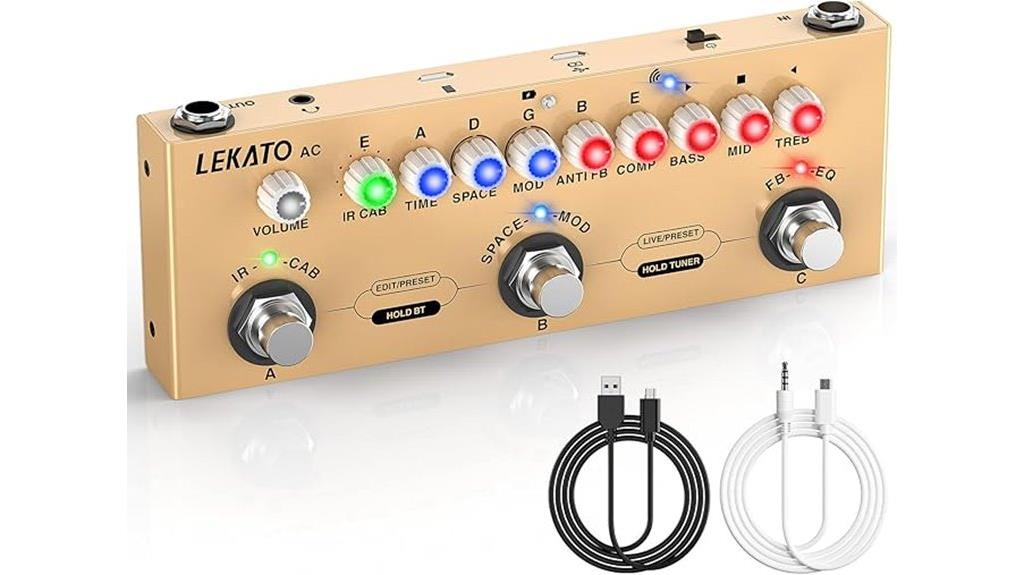
Acoustic guitarists who crave professional-grade effects without the complexity of traditional pedalboards will find the LEKATO Multi Effects Pedal compelling, as it packs nine AMP models, eight IR cabinet simulations, and Bluetooth 5.0 connectivity into a remarkably compact unit that fits in your pocket. You’ll appreciate the chorus, tremolo, delay, and reverb effects alongside the rechargeable battery that delivers six to eight hours of playtime after a two-hour charge. The USB sound card functionality enables direct recording to your phone or computer, though you’ll encounter approximately eleven milliseconds of latency and potentially low output levels requiring careful gain management.
Best For: Acoustic guitarists seeking a portable, all-in-one effects solution with recording capabilities who prioritize convenience and battery-powered operation over maximum sound quality.
Pros:
- Comprehensive feature set with 9 AMP models, 8 IR cabinets, and essential effects (chorus, tremolo, delay, reverb) in an ultra-portable design
- Excellent battery life with 6-8 hours of playtime and quick 2-hour charging, plus ability to operate while charging
- Versatile connectivity options including Bluetooth 5.0, USB sound card functionality, and direct recording to phones/computers
Cons:
- Audio latency of approximately 11 milliseconds and potentially low output levels requiring careful gain management
- Bluetooth connectivity issues when the tuner is engaged, limiting simultaneous functionality
- IR loading software (Cube Suite) can be difficult to install on certain systems, restricting access to custom IR capabilities
Factors to Consider When Choosing Guitar Effects Pedals for Beginners
When I help guitarists choose their first effects pedals, I’ve learned that focusing on five key factors prevents costly mistakes and guarantees you’ll actually use what you buy. Your budget determines whether you’ll start with individual stompboxes or multi-effects units, while understanding essential effect types like overdrive, delay, and reverb helps prioritize purchases that enhance your playing style. I always emphasize that solid build quality, intuitive controls, and reliable power options matter more than flashy features, since these fundamentals determine whether your pedals survive gigs and inspire creativity.
Budget and Value
One fundamental reality I’ve learned through years of testing gear is that setting a realistic budget becomes the cornerstone of making smart pedal choices, especially since effects units span an enormous price range from around $30 for basic single-effect pedals to several hundred dollars for boutique or multi-effects processors. I’ve found that pedals offering 36 to 80 presets deliver exceptional value, providing multiple sound options without requiring separate purchases for each effect type. When evaluating long-term investment potential, I prioritize aluminum alloy construction over plastic housing, as durability considerably reduces replacement costs. Features like true bypass switching and integrated tuners add practical value beyond basic effects processing. I consistently recommend pedals with customer satisfaction ratings above 4.0, as these typically indicate reliable performance that justifies the initial investment.
Essential Effect Types
After establishing your budget parameters, understanding which effect types will serve your playing style becomes the next logical consideration, since different effects fundamentally alter your guitar’s signal in distinct ways that suit various musical applications. I recommend starting with distortion or overdrive pedals, as they’re essential for shaping your core tone and providing the warmer, fuller sound characteristics that most genres demand. Modulation effects like chorus, flanger, and phaser enhance your sound’s richness and depth, creating dynamic textures that’ll keep your playing interesting. Delay pedals add vital echoes and ambient depth, with quality units offering up to 620ms of repeat time. Finally, reverb pedals simulate various acoustic environments, adding the professional polish that separates bedroom players from stage-ready guitarists.
Build Quality Matters
While sound quality often captures our attention first, I’ve learned that build quality determines whether your pedal investment will survive beyond your initial honeymoon period with effects processing. I prioritize aluminum alloy constructions over plastic housings, as they offer enhanced stability and resist wear from countless footstomps and pedalboard adjustments. Most budget-friendly options weigh under one pound, which keeps transport manageable, but I examine whether knobs and switches use durable materials rather than flimsy plastic components that crack under pressure. Compact designs measuring 2-4 inches maintain pedalboard real estate while delivering solid performance, and I’ve found that pedals offering lifetime warranties or customer guarantees typically indicate manufacturers’ confidence in their construction quality, providing valuable peace of mind for beginners.
User-Friendly Controls
Sturdy construction means nothing if you can’t figure out how to operate your pedal effectively, and I’ve discovered that user-friendly controls separate exceptional beginner pedals from frustrating paperweights that collect dust. I prioritize pedals featuring simple knob configurations for Gain, Volume, and Tone adjustments, which allow newcomers to achieve their desired sound without maneuvering complex parameter menus that overwhelm inexperienced players. True bypass switching maintains your original signal chain without unwanted tonal coloration when disengaged, preserving your guitar’s natural voice. Clear LED indicators provide immediate visual confirmation of operational status, eliminating guesswork during live performances when stage lighting makes visibility challenging. Integrated noise reduction minimizes feedback and unwanted artifacts, ensuring cleaner output even with vintage-style effects that traditionally introduce background noise.
Power Supply Options
Three fundamental power considerations determine whether your effects pedal becomes a reliable creative tool or an expensive source of mid-performance frustration, and I’ve learned that understanding these requirements upfront saves countless headaches down the road.
Most pedals demand DC 9V power with center-negative connectors, specifications that must match your power supply exactly to prevent damage. I’ve discovered that many manufacturers don’t include adapters, forcing separate purchases that can quickly add up. Battery-powered options offer several hours of wireless freedom, which I find invaluable for spontaneous jam sessions and outdoor performances.
Understanding these power dynamics helps you manage portability versus convenience trade-offs, especially when shifting from bedroom practice to live performances where reliable power becomes absolutely critical for maintaining your sound.
On a final note
Starting your effects journey doesn’t require breaking the bank, and I’ve found these pedals offer excellent value for developing your signature sound. Whether you choose a single overdrive pedal to learn fundamentals or plunge into multi-effects units with dozens of presets, each option provides reliable performance and room for growth. Remember, the best pedal is one you’ll actually use consistently to explore new sonic territories.

